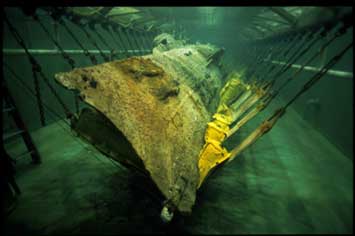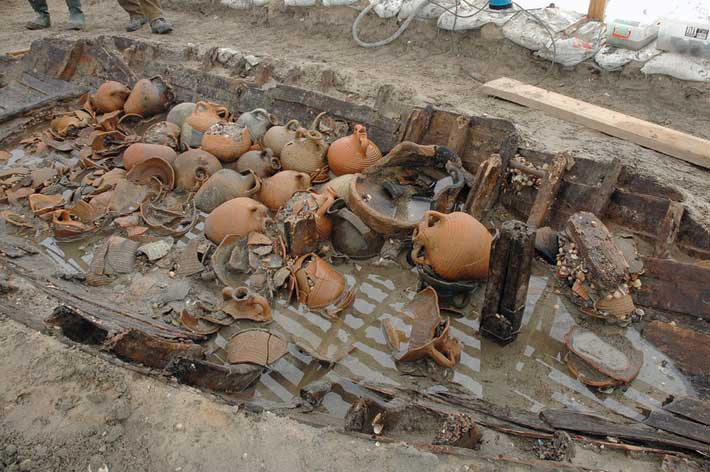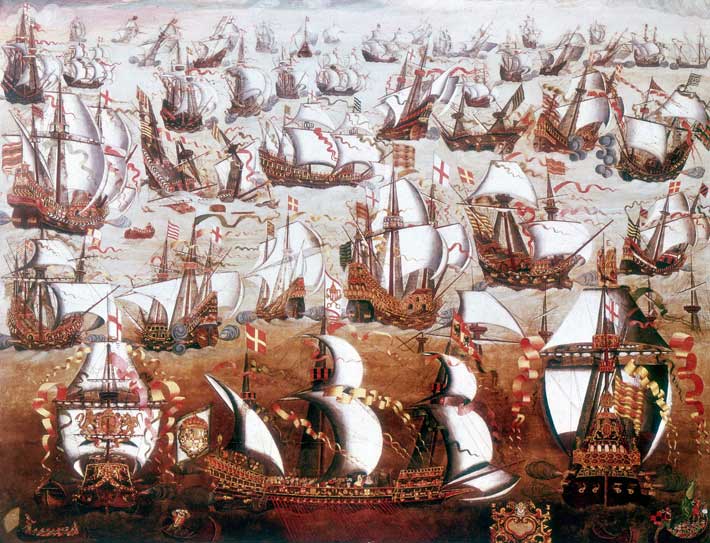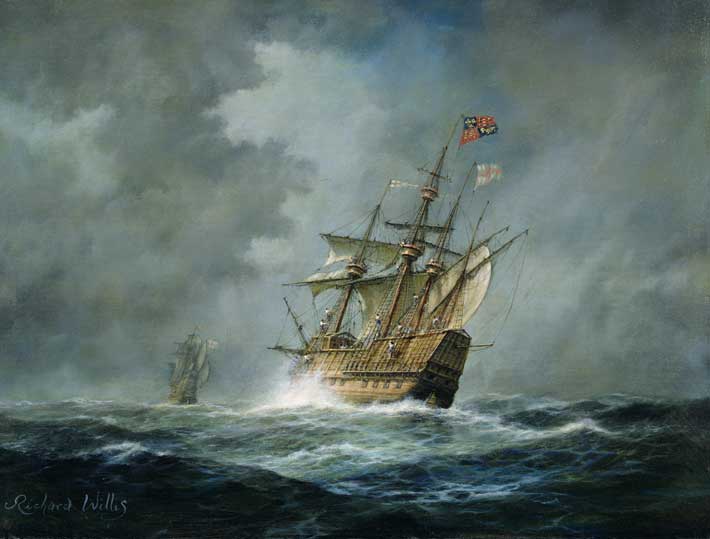10 Greatest Wrecks
RMS Titanic
By JAMES P. DELGADO
Monday, March 11, 2013

The best known maritime disaster of the past few centuries, the sinking of Titanic is remembered for the failure of an engineering marvel equipped with technological advances that were, at the time, believed to render it “practically unsinkable.” The luxury liner took some 1,500 of its 2,200 passengers, from rich and prominent aristocrats to poor immigrants, with it when it struck an iceberg and sank into waters two-and-a-half miles deep. The disaster has inspired countless songs, memorials, books, and films, as well as laws to prevent other ships from going to sea without enough lifeboats and to compel nearby ships to respond to calls for help. Discovered by a joint U.S.-French expedition led by Jean-Louis Michel and Robert D. Ballard in 1985, the wreck of Titanic proved an irresistible lure for explorers, salvagers, and aficionados. Since 1986, more than a hundred deep-sea dives to the wreck have been made, some 5,500 artifacts have been recovered by a private company for public exhibition, and a variety of films, including the James Cameron blockbuster, have been shot at depths once thought inaccessible. Over the past three decades, a variety of other deep-water projects have discovered other wrecks, from the oldest known one in the Gulf of Mexico—a copper-sheathed, early-nineteenth-century vessel found in 2012—to the German battleship Bismarck and the aircraft carrier USS Yorktown. In addition, the discovery of Titanic sparked tremendous interest from explorers and archaeologists, as it showed that the deep ocean, home to many other more or less intact and highly significant shipwrecks, had effectively been “opened up” for research and recovery. A 2012 scientific mission to Titanic used robotic vehicles equipped with sonar and cameras to create a detailed map of the wreck site, as well as high-resolution three-dimensional documentation of the fragmented ship’s various components. Where the original discovery of Titanic marked the deep ocean as the final archaeological frontier, the 2012 Titanic project signaled that archaeological standards can and must be applied to wrecks no matter where they rest. When George Bass began to excavate Cape Gelidonya in 1960, critics claimed that meaningful archaeology could not be done underwater. The five decades since have proven them wrong, even at astounding depths.
USS Monitor and H.L. Hunley
By JAMES P. DELGADO
Monday, March 11, 2013

Two lost warships from the U.S. Civil War were the subjects of long-standing searches because of their historic status to Americans. Monitor was built in a 100-day rush to counter the threat of the Confederate ironclad Virginia (constructed from remnants of USS Merrimac). They met in combat off Hampton Roads, Virginia, in March 1862. The battle heralded the end of naval combat between wooden ships. With its low hull and rotating turret, Monitor was an engineering triumph, albeit one with flaws that became apparent nine months later, when it foundered off the coast of Cape Hatteras, North Carolina, taking 16 of its crew with it. The tiny “cheesebox on a raft” was not forgotten, however, and searches by dedicated volunteers finally rediscovered the vessel in 1973, 240 feet down. Hunley, one of several submarines built by each side during the Civil War, gained fame on February 17, 1864, when it attacked USS Housatonic in the harbor of Charleston, South Carolina, and became the first submarine to sink another vessel in combat. Decades of searches culminated in its rediscovery in 1995. Monitor, designated the first National Marine Sanctuary in the United States, was surveyed and test-excavated before a congressionally directed effort by the National Oceanic and Atmospheric Administration and the U.S. Navy raised its propeller, engine, and armored turret. Now housed in the USS Monitor Center at the Mariners’ Museum in Newport News, Virginia, Monitor’s machinery and turret are undergoing conservation and analysis, while the rest of the wreck remains 17 miles offshore in the sanctuary. Hunley, excavated and raised in 2000 after analysis by the National Park Service’s Submerged Resources Center and the South Carolina Institute of Archaeology and Anthropology, has also been the subject of intense study and conservation, at the Warren L. Lasch Conservation Center outside of Charleston. Undocumented aspects of each vessel’s construction, damage from battle and sinking, and life on board came to light. Hunley, for example, was shown to be an incredibly sophisticated craft, not a crude instrument of war fashioned from boiler iron, as some historians had suggested. Remains of crew members were found in both ships. Forensic work has revealed details about them and, in the case of the Hunley crew, suggests that these men may have died when they brought their craft to settle on the bottom, perhaps for a rest after the crew hand-cranked their sub into battle, only to succumb to foul air.
Yenikapı
By JAMES P. DELGADO
Monday, March 11, 2013

The largest group of Byzantine shipwrecks ever found emerged over the last several years from the mud of a now-landfilled harbor on the edge of Istanbul. Excavation for a massive subway station that commenced in 2004 exposed—in what had once been the port of the emperor Theodosius—harbor walls, 34 ships, and successive layers of human habitation, buildings, and other structures, covering a several-thousand-year period from the late Neolithic to the late Ottoman. Wooden combs, amphorae laden with cargo, and the skeletons of camels transported from Africa to haul stone during harbor construction are just some of the millions of artifacts uncovered. The wrecks range in age from the fourth century B.C. to the eleventh century A.D. and represent different types of Byzantine merchant vessels, fishing boats, and naval craft, many in excellent condition. Several vessels represent types never before documented, including four rowed warships known as galea. The excavation, by Istanbul University and the Institute of Nautical Archaeology has ended, for the most part, but the task of analyzing, conserving, and reassembling the Yenikapı vessels will take decades. Texas A&M University’s Cemal Pulak, who oversaw the recovery of five vessels, considers Yenikapı to be the single most important site yet found for understanding Byzantine ships. Before Yenikapı, archaeologists’ detailed knowledge of Byzantine craft was limited to a handful of discrete sites. One of those is the eleventh-century Serce Limani wreck off the Turkish coast. Though its hull was fragmented, Serce Limani contained a unique cargo: close to a million fragments of glass that, through painstaking lab work, now offer an unprecedented view of medieval Islamic glasswork.
Spanish Armada
By JAMES P. DELGADO
Monday, March 11, 2013

Like Khubilai Khan’s great invasion fleets of the thirteenth century, the Spanish Armada sent by King Phillip II against England in 1588 is legendary not only for its size and power, but also for its defeat and near-annihilation by courageous English sea dogs and the notorious storms along the rock-fanged British coast that lashed the Armada as it fled. Drawn from a variety of ports and sources, the 130-ship, 30,000-man Armada was to invade England, oust Queen Elizabeth I from her throne, and restore a Catholic monarchy, while also ending the Dutch revolt against Spanish authority. The ships included galleons and galleasses, and merchant ships requisitioned from the Baltic and Mediterranean. With some 2,500 guns, the fleet was seemingly unstoppable. Brave and decisive action by English captains is credited with halting it. The English employed tactics such as launching fire ships, vessels set ablaze and sent to crash into and scatter the anchored Armada. The English also had superior rates and accuracy of gunfire. The Armada, driven north, attempted to flee to Spain by circumnavigating the British Isles. As a commemorative medal struck by a victorious Queen Elizabeth noted, “God breathed,” and winter storms lashed the Armada, sending a third of the ships and two-thirds of their mariners and soldiers to watery graves on the shores of Scotland and Ireland. Initially rediscovered by divers eager to find some of the wealth of drowned Spanish noblemen, the Armada wrecks became the subject of decades of archaeological work by Scotland’s Colin C.M. Martin and others. Wrecks such as El Gran Grifon, San Juan de Sicilia, Girona, Santa Maria de la Rosa, and La Trinidad Valencera have yielded evidence of life on board, as well as of the particulars of the ships themselves. Martin’s work has brilliantly shown that poor preparations and haste likely helped doom the Armada, much like the Khan’s invasion fleet. Navigational instruments with mathematical errors along with poorly prepared and badly cast cannons show a lack of care in preparation. The math errors suggest to Martin that Spain’s rigid religious views, which led to the expulsion or forcible “conversion” of Muslim and Jewish citizens after 1492, likely drove off Spain’s most educated, math- and science-literate population. Meanwhile, the two-wheeled, overly long Spanish gun carriages had to be manhandled out of the gun ports, while crews frantically tried to match cannonballs, which, though cast for specific guns, had been tossed indiscriminately into piles. The English had smaller, more easily maneuvered, four-wheeled gun carriages, and uniform-sized guns with shot that fit all their weapons. Archaeology provided the explanation as to why English rapid-fire gunnery was answered slowly, sometimes at a snail’s pace, by Spanish ships with more cannons but no means to use them effectively.
Mary Rose and Vasa
By JAMES P. DELGADO
Monday, March 11, 2013

Two massive, well-preserved warships from the sixteenth and seventeenth centuries were the basis of extensive archaeological projects. The recovery and display of these two impressive survivors from the age of the galleon and the rise of sea power offer an unmatched view of ships as a means of national expansion and domination. Each wreck was filled with weapons, provisions, personal effects, and navigational instruments, as well as preserved clothing and the skeletal remains of their crews. Built in 1509–10 and lost when it capsized while going into battle in 1545, Mary Rose was the pride of English King Henry VIII’s fleet. After excavation on the seabed, which revealed the intact starboard side with four deck levels holding 22,000 artifacts, Mary Rose’s hull was raised to the surface for treatment and display in Portsmouth. The hull’s timbers show how the ship, originally built as a floating fortress for archers and short-range fighting, was modified to accommodate new technology: cannons. Those changes made the ship top-heavy, especially when loaded with supplies and men, leading to its demise. Like Mary Rose, Vasa also capsized. It went to the bottom of Stockholm Harbor on its maiden voyage in 1628. Built to carry 64 cannons and a fighting force, the massive and ornately decorated Vasa was the pride of Swedish King Gustavus Adolphus as he built his nation into a global power. Rediscovered intact and buried in mud—preserved by the cold, brackish waters of the Baltic, which are hostile to wood-devouring marine organisms—Vasa was raised in 1961. Excavation of the seabed and the interior of the ship yielded approximately 25,000 artifacts, including some 700 sculptural pieces that were once attached to the hull. The finds document not only the fitting out and armament of the ship, but also the personal possessions of its crew, from the well-off to the poor, and the skeletal remains of men and women, some still wearing shoes and clothing. After decades of conservation and reassembly, Vasa sits in a custom-built museum in Stockholm. To this day, it remains the world’s largest archaeologically recovered ship.
Advertisement
Page 1 of 2
Advertisement
IN THIS ISSUE
Advertisement

Recent Issues
-
 May/June 2024
May/June 2024
-
 March/April 2024
March/April 2024
-
 January/February 2024
January/February 2024
-
 November/December 2023
November/December 2023
-
 September/October 2023
September/October 2023
-
 July/August 2023
July/August 2023
-
 May/June 2023
May/June 2023
-
 March/April 2023
March/April 2023
-
 January/February 2023
January/February 2023
-
 November/December 2022
November/December 2022
-
 September/October 2022
September/October 2022
-
 July/August 2022
July/August 2022
-
 May/June 2022
May/June 2022
-
 March/April 2022
March/April 2022
-
 January/February 2022
January/February 2022
-
 November/December 2021
November/December 2021
-
 September/October 2021
September/October 2021
-
 July/August 2021
July/August 2021
-
 May/June 2021
May/June 2021
-
 March/April 2021
March/April 2021
-
 January/February 2021
January/February 2021
-
 November/December 2020
November/December 2020
-
 September/October 2020
September/October 2020
-
 July/August 2020
July/August 2020
-
 May/June 2020
May/June 2020
-
 March/April 2020
March/April 2020
-
 January/February 2020
January/February 2020
-
 November/December 2019
November/December 2019
-
 September/October 2019
September/October 2019
-
 July/August 2019
July/August 2019
-
 May/June 2019
May/June 2019
-
 March/April 2019
March/April 2019
-
 January/February 2019
January/February 2019
-
 November/December 2018
November/December 2018
-
 September/October 2018
September/October 2018
-
 July/August 2018
July/August 2018
-
 May/June 2018
May/June 2018
-
 March/April 2018
March/April 2018
-
 January/February 2018
January/February 2018
-
 November/December 2017
November/December 2017
-
 September/October 2017
September/October 2017
-
 July/August 2017
July/August 2017
-
 May/June 2017
May/June 2017
-
 March/April 2017
March/April 2017
-
 January/February 2017
January/February 2017
-
 November/December 2016
November/December 2016
-
 September/October 2016
September/October 2016
-
 July/August 2016
July/August 2016
-
 May/June 2016
May/June 2016
-
 March/April 2016
March/April 2016
-
 January/February 2016
January/February 2016
-
 November/December 2015
November/December 2015
-
 September/October 2015
September/October 2015
-
 July/August 2015
July/August 2015
-
 May/June 2015
May/June 2015
-
 March/April 2015
March/April 2015
-
 January/February 2015
January/February 2015
-
 November/December 2014
November/December 2014
-
 September/October 2014
September/October 2014
-
 July/August 2014
July/August 2014
-
 May/June 2014
May/June 2014
-
 March/April 2014
March/April 2014
-
 January/February 2014
January/February 2014
-
 November/December 2013
November/December 2013
-
 September/October 2013
September/October 2013
-
 July/August 2013
July/August 2013
-
 May/June 2013
May/June 2013
-
 March/April 2013
March/April 2013
-
 January/February 2013
January/February 2013
-
 November/December 2012
November/December 2012
-
 September/October 2012
September/October 2012
-
 July/August 2012
July/August 2012
-
 May/June 2012
May/June 2012
-
 March/April 2012
March/April 2012
-
 January/February 2012
January/February 2012
-
 November/December 2011
November/December 2011
-
 September/October 2011
September/October 2011
-
 July/August 2011
July/August 2011
-
 May/June 2011
May/June 2011
-
 March/April 2011
March/April 2011
-
 January/February 2011
January/February 2011
Advertisement






